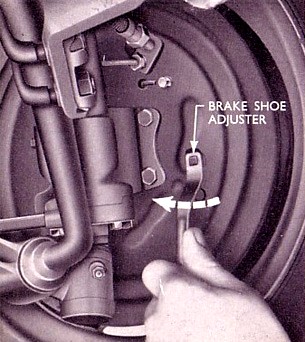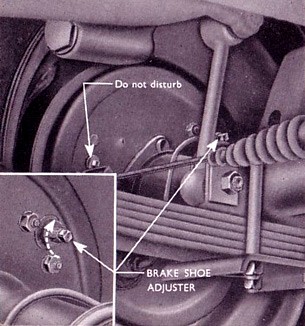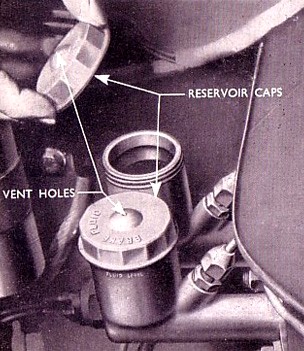You are in:

Braking
System |

General
Maintenance - Braking System
| The braking
system on the car is of the four wheel internal
expanding type and is hydraulically operated on
both front and rear with two leading shoe brakes
on the front wheels. The hand brake operates on the rear
wheels only through the medium of a separate
cable linkage. The foot brake pedal operates the
brakes on all four wheels.
|
Adjusting the Front Brakes
- (5000 Mile Service)
Before making a brake adjustment, ensure that all
four tyres are inflated to the correct pressure.In order to test the
brakes, select a good stretch of road surface,
preferably dry and uncambered. If the braking
action is unequal, or the pedal movement is
excessive, the brakes should be adjusted. Your
Authorised Ford Dealer can make this adjustment
quickly, correctly and economically. If such
service is not readily available, the brakes may
be adjusted for lining wear as follows (it is
advisable to test the front wheel bearings and adjust if necessary)
Check that the
hand brake is in the fully released position and
that the brake drums are cold. There are two
square headed adjusters on each front brake plate
to enable each shoe to be adjusted individually.
Jack
up the
front wheels, turn the adjuster of one shoe
clockwise (using hand pressure) until the drum is
locked, then slacken back to obtain minimum
running clearance.
Repeat this
procedure on the second adjuster, also on the
other front brake.
|

|
Adjusting the Rear Brakes
- (5000 Mile Service)
On each rear brake, a threaded square headed
adjuster is fitted diametrically opposite the
expander unit.Do
not disturb the plain square headed adjuster
positioned on the backplate, your Authorised Ford
Dealer should make this adjustment when it
becomes necessary.
Jack
up the
rear wheels, turn the threaded adjuster clockwise
until the drum is locked, then slacken back to
obtain minimum running clearance. Similarly
adjust the other rear brake.
Do
not jeopardise your safety by makeshift
replacements or adjustments.
It is also of
extreme importance that the linings are kept free
from grease and oil. The use of correct front
wheel bearing lubricant and care not to overfill
the rear axle, as well as replacing grease
retainers when leakage is indicated, will prove
particularly valuable in maintaining braking
efficiency.
|

|
Check the Brake Fluid
Reservoir Levels
- (Weekly Service)
The brake and clutch fluid reservoirs are located
in the engine compartment on the driver’s
side of the car and are integral with their
master cylinders. When checking or replenishing
the system wipe the sides of the reservoirs and
caps with a clean dry cloth to prevent any dirt
entering the system. Do not use a cloth that is
greasy or has been soaked in petrol or paraffin
etc. Remove each cap by unscrewing it and
top up if necessary to the level indicated on the
reservoir casing (approximately 5/8 in (16mm)
from the rim). Use only the correct brake fluid, obtainable from your Authorised
Ford Dealer.
Warning
– MINERAL OILS MUST NOT BE USED IN ANY
CIRCUMSTANCES FOR TOPPING UP THE RESERVOIRS.
|
 |
| Insufficient
fluid in the reservoir can result in air entering
the brake operating system and making the brakes
feel "spongy". If this condition is
suspected, it will be necessary to bleed the air
from the hydraulic system. This operation, if
required at any time, should be carried out by an
Authorised Ford Dealer. |
Information taken from Various Ford
Anglia Instruction Books and Handbooks..

Warning -
The Health and Safety bit.
Please note your health may be at
risk if you do not take sensible safety
precautions. Never work under an unsupported
vehicle, do not take shortcuts. If you feel that
the task is beyond your capabilities, then employ
the services of a trained professional. The Owner
of this Website nor the author cannot be held
responsible for any accidents or injury arising
from advice given on this webpage. Safety advice
can be obtained from the RoSPA.
|




|
|

